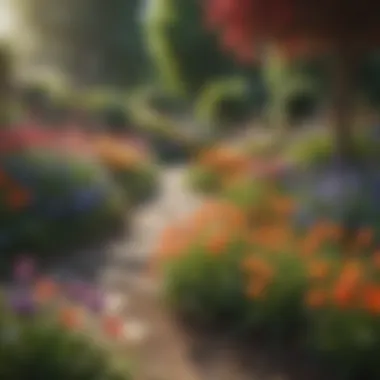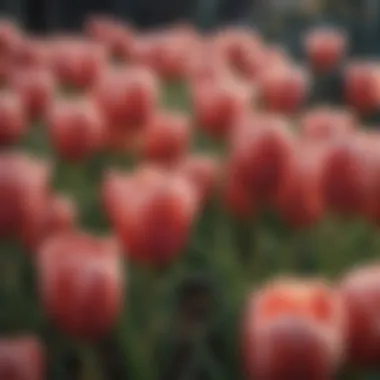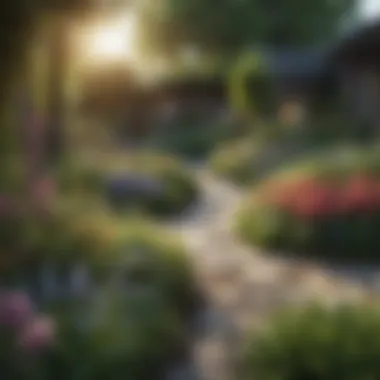Choosing the Best Spring Flowers for Your Garden


Intro
Selecting flowers for spring can significantly alter the aesthetic of your garden. With the season's warmth and the promise of blooms, it’s crucial to choose the right species to enhance your outdoor space. Whether your goal is to create vibrant patches of color or subtle pastels, understanding the characteristics of various flowers aids in establishing a garden that is both beautiful and sustainable.
This guide will offer insight into selecting optimal spring flowers, focusing on their unique traits, care requirements, and ideal arrangements. For both novice and seasoned gardeners, this information lays the foundation for creating an inviting and vibrant garden.
Gardening Know-How
Plant Care Guides
Caring for spring flowers involves more than just planting them. It requires knowledge of the specific needs of each flower type. Some common spring flowers include:
- Tulips: Prefer well-drained soil and full sun. They require watering only after the top inch of soil has dried.
- Daffodils: Thrives in partial shade and loamy soil. Don’t overwater as they can rot.
- Hyacinths: They need a sunny location and should be planted in well-drained soil to prevent rot.
Each species has distinct requirements concerning light, soil, and moisture. Hence, understanding these needs ensures that your garden flourishes.
Seasonal Gardening Tips
Timing is essential when planting flowers in spring. Different flowers have varied optimal planting times. For instance:
- Early Spring: Plant pansies and snapdragons as they handle cooler temperatures well.
- Mid-Spring: Consider planting marigolds and petunias once the risk of frost is minimal.
- Late Spring: This is the time for heat-loving flowers like zinnias and sunflowers.
Monitoring local frost dates is necessary for successfully planning your planting schedule. This attention to detail can lead to a more vibrant garden.
DIY Garden Projects
Experimenting with DIY projects can enrich your gardening experience. Some simple projects include:
- Creating Raised Beds: This improves drainage and reduces weed growth.
- Building a Compost Bin: Compost enriches the soil and provides a sustainable way to recycle garden waste.
- Designing A Pollinator Garden: Selecting flowers that attract birds, bees, and butterflies enhances biodiversity.
Engaging in such projects not only enhances your garden but also provides a sense of accomplishment.
"A well-planned garden can transform your outdoor space into a delightful retreat."
Choosing the right flowers, implementing care techniques, and engaging in meaningful projects contributes to a flourishing garden.
As we move forward in this guide, various sections will delve deeper into each category, offering detailed advice and practical tips tailored for spring gardening enthusiasts.
Understanding the Spring Planting Season
Spring is a pivotal time for gardeners. It marks not just the end of winter but also the commencement of a new growing cycle. Understanding the spring planting season is essential for anyone wishing to cultivate a flourishing garden. The significance lies in the opportunity to refresh your landscape, introducing vibrant colors and new life. In this section, we will explore why spring planting is crucial and what climate considerations should be taken into account.
The significance of spring planting
Spring planting signifies a period of renewal. This is when plants awaken from dormancy. New buds form and the ground thaws, providing a fertile environment for growth. The primary benefit of planting in spring is aligning with nature's rhythms. Plants thrive when they are set during this season, ultimately resulting in a more bountiful harvest or a visually appealing display. Moreover, spring planting allows for extended growing time. This maximizes the window for flowers to blossom, ensuring your garden will be both vibrant and alive during the warmer months.
Consider also the emotional and mental benefits of engaging in this activity. Tending to a garden during spring can serve as a therapeutic practice, an effective way to reduce stress while fostering a connection to nature.
Climate considerations
When planning for spring planting, awareness of climate conditions is paramount. Each flower species has its specific needs in terms of temperature and moisture. Here are several key factors to keep in mind:
- Frost Dates: Knowing the last frost date in your area helps determine when to plant. Pansies, for example, can handle cooler temperatures but might suffer if planted too early.
- Soil Temperature: Many seeds require a certain soil temperature to germinate. Typically, soil temperatures should be around 55°F to 60°F for ideal germination of spring flowers.
- Microclimates: Each garden may have its own microclimate influenced by shade, sun, and wind. Understanding this can lead to more informed decisions about which flowers to select and where to plant them.
"Understanding your specific climate opens the door to the possibilities of creating a mesmerizing garden."
Being cognizant of the unique climate conditions in your region provides a roadmap to successfully selecting and cultivating spring flowers. By integrating this knowledge with the principles of spring planting, gardeners can expect a garden that not only flourishes but brings joy throughout the season.
Popular Flower Varieties for Spring
Selecting popular flower varieties for spring is vital for enhancing the aesthetic appeal of any garden. Various species contribute distinct colors, shapes, and fragrances that welcome the season's arrival. Each variety has its unique characteristics and benefits, making careful selection crucial.


Tulips
Color varieties
Tulips are recognized for their breathtaking range of colors. They can be found in shades from bright red to soft pink, encompassing yellows, purples, and whites. This wide spectrum allows for remarkable visual combinations. The color variety of tulips adds vibrancy to gardens, making them a favored choice among gardeners. However, vibrant colors can sometimes fade under harsh sunlight. Proper selection ensures year-round interest in your garden layout.
Optimal growing conditions
For healthy growth, tulips require well-draining soil and full sun exposure. The key element is good drainage to prevent rotting bulbs. Additionally, tulips thrive in a moderate climate with a cool spring. Choosing the right planting time is crucial for effective blooming. However, tulips can struggle in areas with overly wet or humid conditions, which could adversly affect bulb health.
Maintenance tips
Tulips are relatively low maintenance but do need attention to prevent overcrowding. Ensuring a proper spacing of bulbs can promote healthy growth. A simple step like deadheading wilting flowers encourages further blooming. Summer care consists mainly of allowing the foliage to die back naturally, which allows the bulb to recharge for the next season. Neglecting this could lower blooming potential in future years.
Daffodils
Types of daffodils
There are multiple types of daffodils, including trumpet, double, and triandrus. Each type has distinct features and growth habits. For example, trumpet daffodils are recognized for their long central corona surrounded by petal-like tepals. This diversity allows gardeners to choose varieties that fit specific garden aesthetics or themes. However, some types can be less hardy in certain climates, which should be considered when selecting.
Cultural requirements
Daffodils prefer well-drained soil and can adapt to various light conditions; they thrive in full sun but can tolerate partial shade. Planting requires bulbs to be set at least six inches deep, which aids in stability and encourages rooting. Though hardy, they must be monitored for pests. Underwatering can also be detrimental, so consistent moisture is essential for robust growth.
Ideas for arrangement
When arranging daffodils, their height can be effectively contrasted with lower flowering plants. Planting in clusters provides an impactful visual effect. Their bright yellow or white blooms complement other flowers seamlessly. A common disadvantage includes potential overcrowding, which can reduce individual visibility. Maintaining adequate space ensures that each daffodil can be appreciated.
Hyacinths
Fragrance and colors
Hyacinths are celebrated for their strong, sweet fragrance, making them a favored option for fragrant gardens. Their colors range from deep violet to pale lavender, including bright blues and pinks. The aroma combined with color choice makes them an excellent addition to any spring garden. However, their potent scent can sometimes be overwhelming in enclosed spaces, warranting consideration during planting.
Care and watering
Hyacinths require moderate watering, especially during dry spells. Overwatering can promote diseases, so it's crucial to check soil moisture before watering. They benefit from fertilization during their growth period to enhance bloom quality. However, if neglected, the blooms might not achieve their full potential, leading to disappointing displays.
Best planting practices
Planting hyacinths in late fall to early winter ensures they mature well. Spacing should be around four inches apart to maintain airflow. They prefer well-drained soil to prevent bulb rot and should be planted five to six inches deep. Following these practices will help ensure robust growth and vibrant flowers come spring.
Pansies
Seasonal appeal
Pansies are favored for their cheerful appearance and are often one of the first flowers to bloom in early spring. Their wide range of colors and patterns adds charm to any garden. The unique aspect is their ability to withstand light frost, making them a resilient choice for early spring planting. However, they may decline quickly during the heat of summer, so planning for seasonal transition is necessary.
Sunlight and soil needs
Pansies thrive best in well-draining, nutrient-rich soil with consistent moisture. They prefer full sun with some afternoon shade to prevent wilting. Improper sunlight exposure can cause poor bloom production and leggy growth. Therefore, understanding precise sunlight requirements can significantly influence the overall health of these flowers.
Planting strategies
When planting pansies, it is advisable to group them in odd-numbered clusters to create a natural look. They can be planted alongside other early bloomers for a layered effect. Transitioning from pansies to summer flowers involves careful planning to avoid gaps in bloom. Their short stature allows for versatile placement, appealing in garden beds and containers.
Geraniums
Growth patterns
Geraniums exhibit a bushy shrub-like growth, making them excellent for filling garden spaces. This adaptable plant can serve various roles, from edging to container gardening. The compact growth can overshadow smaller plants if not spaced appropriately. Maintaining harmony in planting layouts is essential for overall aesthetics.
Temperature preferences


Geraniums thrive in moderate temperatures, ideally between 70 to 75 degrees Fahrenheit. They can become vulnerable during extreme temperature changes. Ensuring protection during sudden weather shifts aids their survival. However, prolonged heat can lead to wilting, making regular monitoring of conditions vital.
Propagation methods
Propagation of geraniums can be achieved by cuttings or seed sowing. Cuttings provide faster results and retain the parent plant's traits. However, seeds offer genetic variation which can lead to unique plant characteristics. Understanding the preferred method ensures stocking a diverse garden effectively.
Choosing Flowers Based on Garden Conditions
Selecting flowers according to specific garden conditions is critical for achieving a thriving spring garden. Various factors such as sunlight exposure, soil type, and water availability significantly influence plant health and overall aesthetic. Understanding these conditions helps gardeners make informed decisions that foster growth and bloom. This section will elaborate on these essential elements to guide flower selection effectively.
Sunlight exposure
Sunlight is a key factor that impacts the growth and flowering of plants. Different flowers have varying light requirements. Some prefer full sun, while others thrive in partial shade or full shade. Knowing the sunlight exposure in your garden ensures that the chosen flowers will flourish.
When selecting flowers, observe your garden's light patterns throughout the day. If your garden receives more than six hours of direct sunlight, consider sun-loving varieties like tulips and dahlias. On the other hand, for shaded areas, impatiens and ferns might be a better fit. Always consider the growth habits of the plants; taller flowers might overshadow smaller ones if they are situated too close.
Soil type and quality
Soil greatly affects a plant's growth, and varying types have distinct characteristics. Understanding your garden's soil type helps in choosing flowers that can best adapt to those conditions.
- Loamy soil: Rich in nutrients and excellent for most flowers, this soil type allows for drainage and retains moisture.
- Clay soil: Tends to retain water but can suffocate roots if not properly amended. Flowers like daylilies and asters adapt well here.
- Sandy soil: Drains quickly, often requiring more frequent watering. Consider drought-resistant flowers like sedums or lavender in this case.
It's also essential to check soil quality. A soil test can provide insights into pH levels and nutrient availability. You can enrich soil using compost and fertilizers to suit the needs of chosen flowers.
Water availability
Water is vital for plant survival and influences selection. Regions with inconsistent rainfall or drought conditions require careful flower choices to ensure sustainability. Assess your water resources and select flowers accordingly.
- Drought-tolerant flowers: Varieties such as succulents and ornamental grasses require minimal watering and can thrive in dry conditions.
- Moisture-loving flowers: Plants like astilbes and marsh marigolds need more water and are suitable for areas that retain moisture or near ponds.
Being aware of your watering habits and availability can aid in preventing over or underwatering, which is detrimental to plant health.
In summary, understanding sunlight exposure, soil type, and water availability are fundamental in selecting the right flowers for your garden. These conditions directly influence the vitality of your floral arrangements.
Sourcing Flowers and Planting Materials
Sourcing flowers and planting materials is a crucial aspect of gardening that significantly influences the success and beauty of any spring garden. The process involves identifying where to obtain quality plants, ensuring that they are healthy, and understanding the best practices in planting. Each choice in sourcing affects the overall vitality and appearance of your floral arrangements. By selecting reputable sources, gardeners can achieve robust growth and vibrant colors in their flower beds, leading to a more enjoyable and fulfilling gardening experience.
Local nurseries versus online retailers
When it comes to obtaining spring flowers, the decision between local nurseries and online retailers is significant. Local nurseries often offer a distinct advantage by allowing gardeners to see plants firsthand. This physical inspection helps to assess the health and condition of each plant. Furthermore, local nurseries frequently provide personalized advice tailored to the unique regional climate and soil conditions. Engaging directly with staff can lead to discovering lesser-known species suitable for the area.
On the other hand, online retailers offer convenience and variety. A quick search can unveil a vast range of flowers not typically available locally. This means gardeners can access rare or exotic varieties. However, buying online has its risks. Plants may arrive damaged or not as expected. When choosing online options, it is vital to research and read reviews about the seller's reputation. Consideration of delivery times and guarantees should also be part of the decision-making process.
Evaluating plant health
Assessing the health of plants before bringing them into your garden is essential. Healthy plants are more likely to thrive once planted. A few signs can help determine the vitality of a flower before purchase. Look for vibrant, glossy leaves that are free from discoloration or spots. The stems should be firm and not limp. Check for any signs of pests or disease, such as webbing or unusual growths.
Another aspect to consider is the root system. For potted plants, roots should not be tightly bound. If they are in a container, gently slide the plant out and inspect the roots. Healthy roots appear white and fibrous, indicating good growth. Conversely, dark or mushy roots often suggest rot or disease.
"The duration of the plants' journey from nursery to garden affects its resilience. Always prioritize plant health for lasting beauty."
Before making a final decision, ask staff members for advice regarding any potential issues seen. Knowledgeable staff can provide insights into the plants’ care requirements and history. Paying attention to these factors increases the chances of selecting robust flowers that will flourish in your garden.
Maintenance and Care for Spring Flowers
Caring for spring flowers is essential for achieving a vibrant and lasting garden. Proper maintenance not only promotes healthy growth but also enhances the visual appeal of your outdoor space. This section outlines fundamental practices that can ensure the longevity and beauty of your flowers.
Watering practices
Watering plays a critical role in the health of spring flowers. Each flower variety has specific watering needs, which must be considered to avoid overwatering or underwatering. Watering in the early morning is often the best time, as it allows moisture to reach the roots without promoting disease. Here are a few key points:


- Frequency: Generally, most spring flowers need water about once a week. However, this may vary based on climate and soil conditions. During dry spells, increase the frequency.
- Soil Moisture: Check the soil moisture by feeling it about an inch below the surface. If it feels dry, it's time to water.
- Depth of Watering: Ensure the water reaches deep into the soil. Shallow watering might lead to poor root development.
By adhering to these practices, gardeners can maintain a healthy balance that supports flower growth and bloom quality.
Fertilization schedules
Fertilizing spring flowers is another important aspect of maintenance. The right nutrients can significantly affect flower size, color, and overall health. Timing and type of fertilizer are both crucial in creating a successful fertilization plan. Here are some considerations:
- Initial Application: Begin fertilizing about a month after planting. This is when your plants will start to actively grow.
- Type of Fertilizer: Use a balanced fertilizer that caters to your specific flowers. For example, slow-release granules are often effective.
- Frequency: Fertilize every four to six weeks during the growing season. Adjust the schedule based on plant growth and signs of nutrient deficiency.
Incorporating these fertilization practices encourages robust flowering and helps sustain the plants through their growth phase.
Pest management techniques
Pests can be a significant threat to the health of spring flowers. Early identification and management are critical to protect your plants from damage. Employing integrated pest management strategies can create a sustainable approach to pest control. Important techniques include:
- Regular Monitoring: Check plants regularly for signs of pests or disease, including discoloration or webbing. Early detection can make management much easier.
- Natural Predators: Encourage beneficial insects like ladybugs and lacewings which naturally control pest populations.
- Organic Treatments: If pests are detected, consider using organic solutions like neem oil or insecticidal soap. These are often less harmful to beneficial insects while being effective against common pests.
Creating a pest management plan helps sustain healthy flowers and reduces the need for harsher chemicals that could damage the environment.
"A well-maintained garden not only enhances the aesthetic of your home but also provides a rewarding experience for any gardening enthusiast."
By focusing on these maintenance and care strategies, gardeners can cultivate a thriving spring garden that reflects their efforts and passion for floral beauty.
Creating Floral Arrangements with Spring Flowers
Creating floral arrangements with spring flowers is a rewarding endeavor that merges creativity with nature's beauty. This section will explore the significance of well-thought-out arrangements, focusing on color selection and design principles. Understanding how to combine different floral varieties can greatly enhance both indoor and outdoor spaces, providing visual interest and seasonal charm.
Selecting complementary colors
Selecting complementary colors is fundamental in designing attractive floral arrangements. Flowers have distinct hues that can evoke emotions and set the tone for any setting. When choosing colors, consider the following:
- Color Wheel: Familiarity with the color wheel can assist gardeners in identifying complementary colors. Colors opposite each other create contrast, while those next to each other offer harmony.
- Seasonal Themes: Spring flowers typically bloom in vibrant colors like pastels or bold shades. Combining these can reflect the ease and joy associated with the season. For instance, pairing yellow daffodils with purple pansies creates a fresh and lively atmosphere.
- Personal Preference: Tailor arrangements to your own taste. Select shades that resonate with your aesthetic, ensuring that the final result embodies your unique style.
When arranging flowers, balancing cool and warm tones can also create depth and visual appeal. The right color combinations bring flowers to life, transforming a simple arrangement into a striking focal point.
Design principles for arrangements
Designing effective floral arrangements involves applying certain principles that elevate the overall look. Here are some key considerations:
- Balance and Symmetry: Ensure your arrangement has a sense of balance. This can be achieved through symmetrical designs or asymmetrical arrangements that still feel visually stable.
- Focal Point: A successful arrangement often includes a focal point. This can be achieved by using larger flowers or more vibrant colors in a central position, drawing the eye effectively.
- Spacing: Adequate spacing between flowers allows each bloom to stand out. Overcrowding should be avoided as it can detract from the overall visual impact.
- Proportion: Adjust the size of your flowers relative to one another. Using larger blooms with smaller ones can create an appealing contrast that adds interest.
- Texture: Incorporating different textures adds depth to floral arrangements. Mixing smooth petals with ruffled ones or including foliage can enhance the arrangement dramatically.
Understanding these design principles can transform an ordinary bouquet into a stunning centerpiece.
End and Final Tips
Selecting the right spring flowers for your garden requires thoughtful consideration. As spring approaches, the choices you make about floral selections will significantly influence not only the aesthetics of your outdoor space but also the overall health of your garden. This section wraps up the essential insights discussed throughout the article. It underscores the importance of understanding your garden's unique conditions and the characteristics of various blooms.
In summary, it is crucial to reflect on the various factors that affect your selection process:
- Climate: Choose flowers suited to your local conditions.
- Soil Quality: Understand the type of soil you have and select flowers that thrive in it.
- Watering Needs: Some flowers require more moisture than others; knowing these needs will help prevent over or under-watering.
Ultimately, every garden is distinct. Consider creating a plan that incorporates diverse species to ensure a vibrant spring display.
Recap of key floral choices
To solidify your knowledge, here’s a summary of the standout flowers mentioned:
- Tulips: Renowned for their broad color range and graceful shapes, tulips are a spring staple.
- Daffodils: These resilient flowers symbolize renewal and come in various types, making them versatile in arrangements.
- Hyacinths: Known for their intense fragrance, they add depth to any floral display.
- Pansies: With their charming faces, pansies can thrive in cooler temperatures and add color when few other flowers are blooming.
- Geraniums: Their staying power in gardens makes them a favorite, especially for warmer spots.
Each of these flowers has unique properties that enhance any landscape.
Encouragement for personal creativity
As you embark on your gardening journey, do not hesitate to incorporate your personal style. Create arrangements that reflect your character and vision. Here are a few ideas to foster your creativity while planting:
- Experiment with Color Combinations: Try pairing contrasting colors for visual impact or use analogous colors for a soothing effect.
- Vary Heights: Mix flowers of different heights to create visually interesting layers.
- Include Different Textures: Use foliage and unique flower shapes to build texture in arrangements.
Gardening is not just about following guidelines; it is an art. Feel free to break the rules to achieve a look that resonates with you. This spring, let your flowers not only beautify your garden but also express your personal story.







